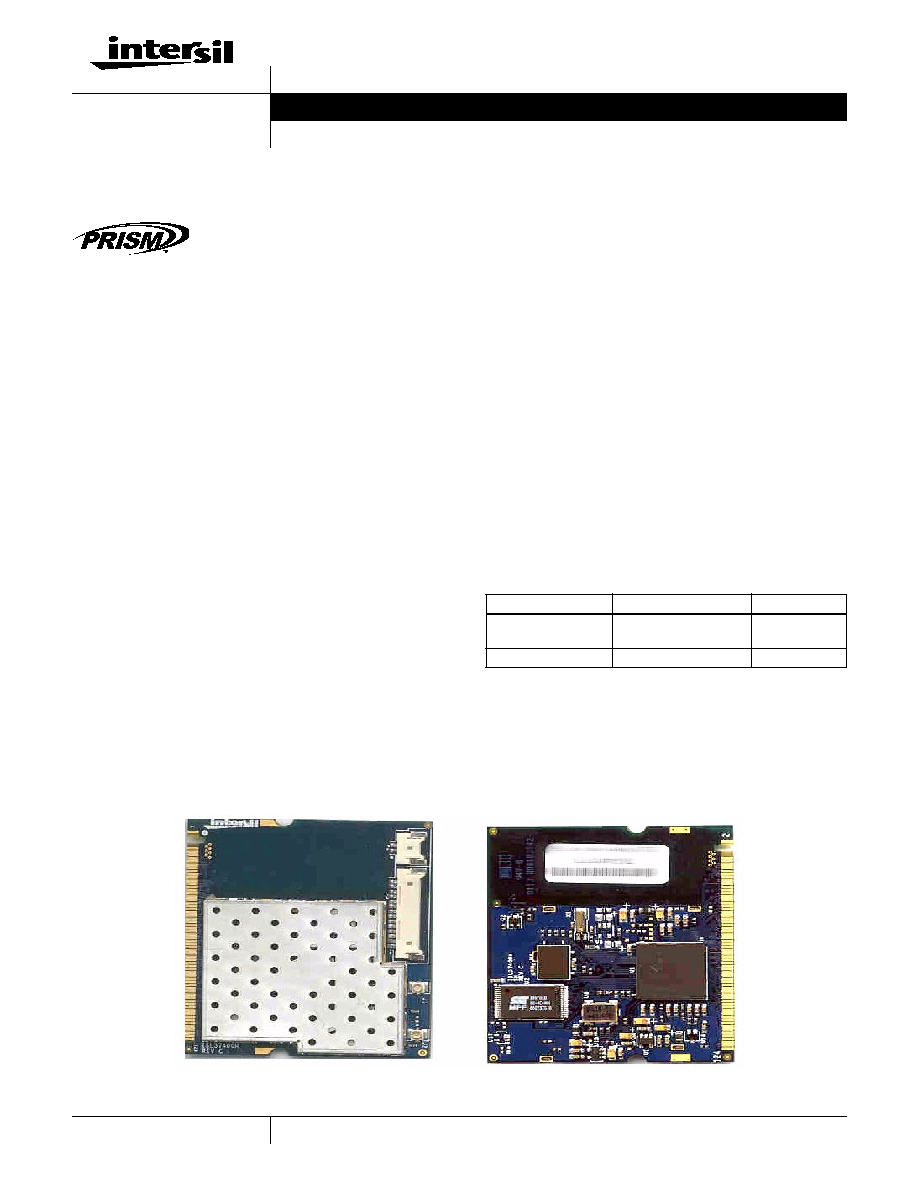
1
TM
FN8022.3
CAUTION: These devices are sensitive to electrostatic discharge; follow proper IC Handling Procedures.
1-888-INTERSIL or 321-724-7143
|
Intersil and Design is a trademark of Intersil Americas Inc.
Copyright © Intersil Americas Inc. 2001, All Rights Reserved PRISMÆ is a registered trademark of Intersil Americas Inc. PRISM and design
is a trademark of Intersil Americas Inc. MicrosoftÆ, WindowsÆ and Windows NTÆ are registered trademarks of Microsoft Corporation.
ISL37400M-EVAL
PRISM
Æ
2.5 11Mbps Wireless Local Area
Network miniPCI
The Intersil ISL37400M WLAN miniPCI
(Note 1) is a complete wireless high
speed network interface card (NIC)
utilizing the Intersil PRISM 2.5 Direct
Sequence Spread Spectrum (DSSS) Wireless Transceiver
chip set. It provides a complete PRISM 2.5 reference design
evaluation platform of hardware and software to system
providers or integrators requiring wireless data
communications capability and is ideal for integration into
computer platforms.
Evaluation kits include a WLAN miniPCI and a WLAN
PCMCIA designed to Intersil's PRISM reference design,
MicrosoftÆ WindowsÆ driver, LAN evaluation software,
PRISM Transmitter Test Utilities (PTTU) software (Note 3)
and documentation to get your evaluation started quickly. It
supports the IEEE802.11 network specification for DSSS
signaling, providing data rates of 1, 2, 5.5 and 11Mbps.
Access points are available from a number of suppliers,
enabling a total wireless network solution. Typical operating
ranges are shown in Table 1.
A complete PRISM chipset WLAN reference design package
(ISL37400M-CD) is also available. The reference design
package contains all the documentation needed for the
manufacture of the PRISM 2.5 miniPCI WLAN card including
Cadence/Allegro Layout, Gerber files, Concept Schematic,
Bill of Materials, Assembly and Mechanical Drawings, Test
Plan, and a copy of the application for FCC equipment
authorization. Customers who license the reference design
also receive password access to Intersil's Premier Web Site
for up-to-the-minute updates on hardware and software.
Features
∑ FCC-certified under Part 15 to operate in 2.4GHz ISM
band
∑ Support for 11, 5.5, 2 and 1 Mbps data rates
∑ Supports the lEEE 802.11 direct sequence specification
∑ Driver supports Microsoft Windows 95, 98, 98SE, 2000,
CE, ME and Microsoft Windows NTÆ4
∑ Supports dual diversity antennas
∑ Advanced RAKE receiver design with Decision Feedback
Equalizer
∑ Provides wireless data communications at full ethernet
speed
∑ Designed to fully support miniPCI Type 3A-defined
mechanical and environmental stress conditions
∑ Intelligent power control, including IEEE802.11 power
save mode
∑ Complete reference design; the ISL37400M-CD is
available to ensure minimum time-to-market
PRISMÆ is a registered trademark of Intersil Americas Inc.
PRISM and design is a trademark of Intersil Americas Inc.
MicrosoftÆ WindowsÆ and MicrosoftÆ Windows NTÆ are
registered trademarks of Microsoft Corporation.
Packaging
Ordering Information
PART NUMBER
DESCRIPTION
CARDS/SET
ISL37400M-EVAL
WLAN Evaluation Kit
1 miniPCI
1 PCMCIA
ISL37400M-CD
Reference Design
n/a
Data Sheet
December 2001

2
Functional Overview
The WLAN miniPCI is designed to operate in the 2.4GHz ISM
frequency band, channels 1 to 11, as specified by the FCC in
the USA. The card will also operate on channels 12 through 14,
where permitted by local regulatory authorities. Radio
equipment must be certified in a country prior to use. Refer to
Table 4 for a list of countries and agencies that have approved
the ISL37400M-EVAL for operation.
The Intersil PRISM Chip Set allows for high level integration
for reduced size, increased throughput, improved radio
performance and faster time to market. The WLAN miniPCI
implements DSSS technology providing superior noise and
signal jamming immunity, including less severe impact from
unintentional radiators such as microwave ovens. The user
can connect the miniPCI in an ad-hoc peer-to-peer
networking scheme, allowing for instant network setup in any
office environment. By using an access point, the wireless
LAN can be set up to allow for a greater number of users to
interconnect, and to increase the coverage area. With a portal
(i.e., Access Point), the wireless LAN can be easily
connected into an existing wired LAN, allowing for easy
expansion of the service.
Compared to the PRISM II chip set, the PRISM 2.5
generation offers:
∑ Low-loss front end designed for maximum range
∑ Higher level of chip integration and less peripheral
components, reducing material costs
∑ Support of optional IEEE802.11 Short Preamble for
significantly increased data throughput with room for
additional user-defined functions
∑ Has a miniPCI interface/Type 3A form factor
A complete reference design for the ISL37400M is available to
ensure minimum time-to-market. This information contains
details for manufacturing a miniPCI WLAN assembly,
including Gerber PC board files, an accurate bill of material
with component sourcing and complete mechanical drawings
and a complete radio description and test plan.
Related Literature
∑ Tech Brief TB337, Intersil Corporation, A
Brief Tutorial on
Spread Spectrum and Packet Radio
[1].
∑ Tech Brief TB382, Intersil Corporation,
Measurement of
WLAN Receiver Sensitivity
[2].
∑ Application Note AN9850, Intersil Corporation,
Complementary Code Keying Made Simple
[3].
∑ Application Note AN9829, Intersil Corporation,
Brief
Tutorial on IEEE802.11 Wireless LANs
[4].
∑ Application Note AN9820, Intersil Corporation,
A
Condensed Review of Spread Spectrum Techniques for
ISM Band Systems
[5].
The ISL3874 Media Access Controller
(MAC) Protocol Handler
The ISL3874 MAC/Baseband Processor and its firmware are
responsible for running the IEEE802.11 protocol in the
WLAN card. This section describes the features of
IEEE802.11 that are implemented.
The functions supported by the STA (station) Firmware are:
∑ CSMA/CA (Carrier Sense Multiple Access with Collision
Avoidance) with random backoff
∑ WEP security
∑ Short/long preamble with multirate
∑ RTS/CTS handshake (ready to send/clear to send) and
NAV management (network allocation vector)
∑ MAC level acknowledgments
∑ Retransmission of unacknowledged frames
∑ Duplicate detection and rejection
∑ Broadcast and multicast frames
∑ Fragmentation and re-assembly
∑ Power management (planned)
∑ Timestamp synchronization
∑ DCF (distributed coordination function)
∑ PCF (point coordination function)
∑ Beacon generation in an ad-hoc network
∑ Probe response generation in an ad-hoc network
Card Information Structure
The standard Intersil WLAN miniPCI will be supplied with
information embedded in the Plug and Play (PnP) shown in
Table 2. It should be noted that in most systems this
information is displayed when the card is inserted.
Customization of the PnP for specific customer requirements
is available upon request, to enable customer information to
be displayed when the card is inserted.
TABLE 1. TYPICAL OPERATING RANGE
(Notes 2, 4)
DATA RATE (Mbps)
INDOOR RANGE
OUTDOOR RANGE
11
120 feet (37 meters)
500 feet (152 meters)
5.5
200 feet (61 meters)
800 feet (243 meters)
2
240 feet (73 meters)
1300 feet (396 meters)
1
300 feet (91 meters)
1750 feet (533 meters)
NOTES:
1. Throughout this document, all references to `miniPCI', `WLAN
adapter', `adapter', or `card' refer to a card assembly conforming
to the mechanical size specifications of the miniPCI Type 3A.
2. The range will vary in different operating environments due to
effects such as building construction.
3. At present, PTTU supports Windows 95, 98, NT, 2000 and ME
4. Data taken using custom proprietary antennas in a custom
proprietary laptop computer.
ISL37400M-EVAL

3
IEEE802.11 International Agreement and
Frequency Assignments
The IEEE802 LAN committee has forged an international
agreement providing for wireless data communication
standards for the frequency range of 2.4GHz to
2.4835GHz, as allocated by the FCC in the USA, and in the
2.471GHz to 2.497GHz frequency range, as specified by
the regulatory authority in Japan. These standards are
designed to focus the industry to develop highly integrated,
low cost, interoperable WLAN equipment, of which the
ISL37400M-EVAL is a prime example.
In the USA, there are 11 channels specified by the FCC in
the 2.412GHz to 2.462GHz range. In Japan, channel 14 at
2.484GHz is authorized under ARIB STD-33 and channels
1-13 are authorized under ARIB STD-T66. The ETSl
(European) regulatory body conforms to the USA (FCC)
channel assignments with the exception that channels 12
and 13 are also allowed. Some countries in Europe, notably
France and Spain have unique channel restrictions.
Although information contained in Table 3 is deemed to be
accurate, local regulatory authorities should be consulted
before using such equipment.
The available channels of operation in the 2.4GHz to
2.4835GHz and 2.471GHz to 2.497GHz ranges are as follows:
The ISL37400M is shipped with FCC-compliant firmware. In
order to ensure regulatory-compliant channel usage in a
particular country, special geographic-specific firmware is
available for customer production assemblies which restricts
channel usage. Examples include ETSI-compliant firmware,
etc. Since the end user does not have the ability to alter this
firmware, regulatory compliance is ensured.
Agency and Regulatory Body Approvals
The WLAN miniPCI will comply to the standards shown in
Table 4:
TABLE 2. CIS PLUG AND PLAY (PnP)
FUNCTION NAME
CONTENT
Manufacturer's ID
00
Function ID
Network Adapter
Product Revision
1
Manufacturer
Intersil Corporation
Product
12603873
PROG
LOT
TABLE 3. IEEE802.11 CHANNELS
CHANNEL
NUMBER
CHANNEL
FREQUENCY
GEOGRAPHIC
USAGE
1
2412MHz
US, CA, ETSI, MKK
2
2417MHz
US, CA, ETSI, MKK
3
2422MHz
US, CA, ETSI, MKK
4
2427MHz
US, CA, ETSI, MKK
5
2432MHz
US, CA, ETSI, MKK
6
2437MHz
US, CA, ETSI, MKK
7
2442MHz
US, CA, ETSI, MKK
8
2447MHz
US, CA, ETSI, MKK
9
2452MHz
US, CA, ETSI, MKK
10
2457MHz
US, CA, ETSI, MKK, FR, SP
11
2462MHz
US, CA, ETSI, MKK, FR, SP
12
2467MHz
ETSI, FR, MKK
13
2472MHz
ETSI, FR, MKK
14
2484MHz
MKK
KEY:
US = United States, CA = Canada, ETSI = European
countries (except France and Spain),
FR = France, SP = Spain, MKK = Japan
TABLE 4. COMPLIANCE STANDARDS
COUNTRY
APPROVAL
NOTES
USA
FCC part 15,
Sec. 15.247,
Sec. 15.107 and 15.109
Approved for
Intentional
Radiators &
Computer
Peripheral
Canada
ICAN RSS-210
Designed for
compliance
Europe
EN 60950
EN 301 489-1 V1.2.1 (2000-08)
EN 301 489-17 V1.1.1 (2000-09)
EN 300 328 Part 1 V1.2.2 (2000-07)
EN 300 328 Part 2 V1.1.1 (2000-07)
Designed for
compliance
Japan
ARIB STD-T66
ARIB STD-33
Designed for
compliance
TABLE 3. IEEE802.11 CHANNELS (Continued)
CHANNEL
NUMBER
CHANNEL
FREQUENCY
GEOGRAPHIC
USAGE
ISL37400M-EVAL

4
FCC Information to User
This product does not contain any user serviceable
components and is to be used with approved antennas only.
Any product changes or modifications will invalidate all
applicable regulatory certifications and approvals.
FCC Electronic Emission Notices
This device complies with Part 15 of the FCC Rules.
Operation is subject to the following two conditions:
1. This device may not cause harmful interference
2. This device must accept any interference received,
including interference that may cause undesired
operation.
FCC Radio Frequency Interference statement
The wireless LAN card is subject to the rules of the Federal
Communications Commission (FCC). This card is
considered an intentional radiator as per the FCC guidelines.
NOTE: This equipment has been tested and found to
comply with the limits for Class B digital device, pursuant to
Part 15 of the FCC rules. These limits are designed to
provide reasonable protection against harmful interference
in a residential installation. This equipment generates, uses
and can radiate radio frequency energy and, if not installed
and used in accordance with the instruction manual, may
cause harmful interference to radio communications.
However, there is no guarantee that interference will not
occur in a particular installation. If this equipment does
cause harmful interference to radio or television reception,
which can be determined by turning the equipment off and
on, the user is encouraged to try to correct the interference
by one or more of the following measures:
∑ Reorient or relocate the receiving antenna.
∑ Increase the separation between the equipment and
receiver.
∑ Connect the equipment into an outlet on a circuit different
from that to which the receiver is connected.
∑ Consult the dealer or an experienced radio/TV technician
for help.
WARNING
Any changes or modifications of equipment not
expressly approved by Intersil could void the user's authority
to operate the equipment.
FCC Guidelines for Human Exposure
The EIRP was measured for the lower, middle and highest
frequencies used by the transmitter. The results in Table 5
are based on a safe distance between antenna and
operator of eight inches.The equipment therefore fulfills the
requirements on power density for general population /
uncontrolled exposure of 1.0mW/cm
2
and therefore
complies with the requirements of FCC part 15.247 (b) (4)
and FCC OET Bulletin 65 including supplements A, B and C.
CAUTION:
This assembly is designed to operate with a
supply voltage of 3.3V in laptop computers supporting the
miniPCI standard.
CAUTION:
Do not force engagement of the card in the
miniPCI slot. It is mechanically designed to prevent improper
insertion.
Permanent damage may occur if operated outside of the
specified operating limits listed in this document.
References
For Intersil documents available on the internet, see web site
http://www.intersil.com/
[1] TB337 Tech Brief, Intersil Corporation,
A Brief Tutorial on
Spread Spectrum and Packet Radio
.
[2] TB382 Tech Brief, Intersil Corporation,
Measurement of
WLAN Receiver Sensitivity
.
[3] AN9850 Application Note, Intersil Corporation,
Complementary Code Keying Made Simple
.
[4] AN9829 Application Note, Intersil Corporation,
Brief
Tutorial on IEEE802.11 Wireless LANs
.
[5] AN9820 Application Note, Intersil Corporation,
A
Condensed Review of Spread Spectrum Techniques for
ISM Band Systems
.
[6] AN9895 Application Note, Intersil Corporation,
Multipath
Measurement in Wireless LANs.'
[7] FN8006 File Note, Intersil Corporation,
PRISM 2.5,
11Mbps Chip Set Overview for miniPCI.
Further information can be found in the following:
∑ Intersil PRISM 2.5 Chip Set data sheets, web home page,
http://www.intersil.com/design/prism/ser-p25-11mbps.asp
∑ IEEE802.11 Standards Project (available from the IEEE,
New York, USA).
TABLE 5. POWER DENSITY CALCULATION
Ch.1
Ch.6
Ch.11
Measured EIRP
(mW)
66.1
67.6
64.6
Calculated Power
Density (mW/cm
2
)
0.052
0.053
0.051
ISL37400M-EVAL

5
Absolute Maximum Ratings
Operating Conditions
Supply Voltage . . . . . . . . . . . . . . . . . . . . . . . . . . -0.3V to 4.0V (Max)
Storage Temperature (Note 5) . . . . . . . . . . . . . . . . . . -20
o
C to 85
o
C
Temperature Range . . . . . . . . . . . . . . . . . . . . . . . . .0
o
C
T
A
70
o
C
Supply Voltage Range . . . . . . . . . . . . . . . . . . . . . . . . . . 3.0V to 3.6V
Caution: These are the absolute maximum ratings for the miniPCI product. Exceeding these limits could cause permanent damage to the card.
NOTE:
5. All temperature references refer to ambient conditions.
Electrical Specifications
Test Conditions: Supply Voltage (V
CC
) = 3.3V, Ambient Temperature (T
A
) = 25
o
C,
Unless Otherwise Specified
PARAMETER
SYMBOL
TEST CONDITIONS
MIN
TYP
MAX
UNITS
CURRENT CONSUMPTION
Initialization Current
I
CC
-
145
180
mA
Average Current
(2% TX; 8% RX; 90% Standby)
(With Power Saving Mode)
I
CC
-
140
-
mA
Continuous Transmit Mode
I
CC
-
325
380
mA
Continuous Receive Mode
I
CC
Receiving Valid Packets
-
200
225
mA
802.11 Power Save Mode
I
CC
-
63
-
mA
miniPCI LOGIC LEVELS
Input HIGH Voltage
V
IH
V
CC
=Max, Min
0.7V
CC
-
-
V
Input LOW Voltage
V
IL
V
CC
=Min, Max
-
-
0.3V
CC
V
Output HIGH Voltage
V
OH
I
OL
= 2mA, V
CC
=Min
0.9V
CC
2.6
-
V
Output LOW Voltage
V
OL
I
OL
= 2mA, V
CC
=Min
-
0.05
0.1V
CC
V
Input Leakage Current
I
I
V
CC
=Max, Input=0V or V
CC
0.100
1.0
µ
A
miniPCI LOADING CAPACITANCE
Input Capacitance
C
IN
-
5
10
pF
Output Capacitance
C
OUT
-
5
10
pF
RF SYSTEM SPECIFICATIONS
Transmitter Power Output
P
out
-
16
-
dBm
Receive Sensitivity
RX_S
1Mbps, 8% PER
-
-93.2
-
dBm
2Mbps, 8% PER
-
-90.9
-
dBm
5.5Mbps, 8% PER
-
-89.4
-
dBm
11Mbps, 8% PER
-
-85.8
-
dBm
Multipath Delay Spread using
IEEE802.11b Naftali Model
T
DELAY
2Mbps, 8% PER
-
>290
-
ns
5.5Mbps, 8% PER
-
200
-
ns
11Mbps, 8% PER
-
105
-
ns
ISL37400M-EVAL




